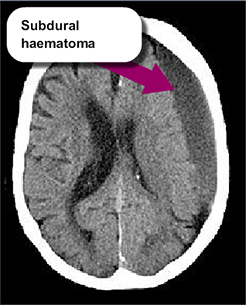Keith normally keeps well, but has diabetes and was diagnosed with AF, and was put on an oral anticoagulant 3 months ago. He has been a little confused over the last month. He seemed OK when having breakfast at 8.00am, but his wife heard him fall at 8.30. She found he was unable to speak, had right facial droop weakness of his right arm and leg. He had hit his head and was bleeding from his nose. She called 999, the paramedics did the FAST test, they checked his BM which as 3.2mmol/l, pre-alerted the hospital and he arrived at 9.15am. His blood pressure was 210/90 when he arrived in the Emergency Dept.
Keith’s CT scan

The CT scan shows a large hypodense (darker grey than brain tissue) subdural haematoma over the left hemisphere which is causing marked shift of the midline structures to the right and has effaced (i.e. squashed) the left lateral ventricle. The low density of the subdural collection suggests that it is chronic (i.e. has been present for some weeks). If the bleeding had occurred in the last few hours or days it would have appeared hyperdense (whiter than brain tissue, see CT 5 on the previous page).
In retrospect it seems most likely that the subdural has been present for over a month, was caused by the anticoagulation and caused his confusion over the last month. Subdurals can cause sudden worsening of neurological function mimicking a stroke.
Should Keith be treated with thrombolysis or thrombectomy? Select Yes or No. Explore the slides for more.
Slide 1
Q. Should Keith be treated with thrombolysis or thrombectomy?
Yes – Wrong – Definitely not. He has not had a stroke, and giving somebody with intracranial bleeding thrombolysis is likely to be fatal.
No – Correct – He has not had a stroke, and giving somebody with intracranial bleeding thrombolysis is likely to be fatal.
Slide 2
Red – STOP – do not give thrombolysis treatment
Amber – THINK – about other causes of condition
Green – CONSULT – with other colleagues
Slide 3
Q. Should Keith be discussed with a neurosurgeon?
Yes – Correct – depending on the size of the subdural and the patient’s condition an operation to drain the haematoma may be necessary. However often they resolve without surgical treatment. The anticoagulant will usually be stopped, at least temporarily.
No – Wrong – depending on the size of the subdural and the patient’s condition an operation to drain the haematoma may be necessary. However often they resolve without surgical treatment. The anticoagulant will usually be stopped, at least temporarily.


